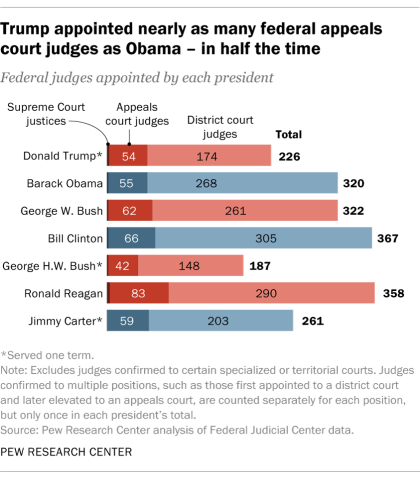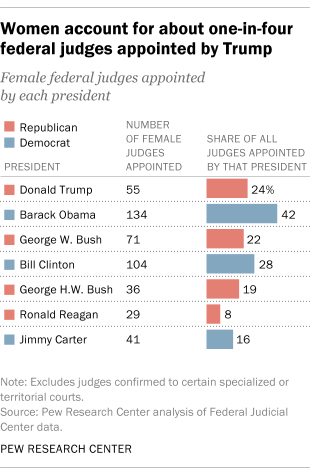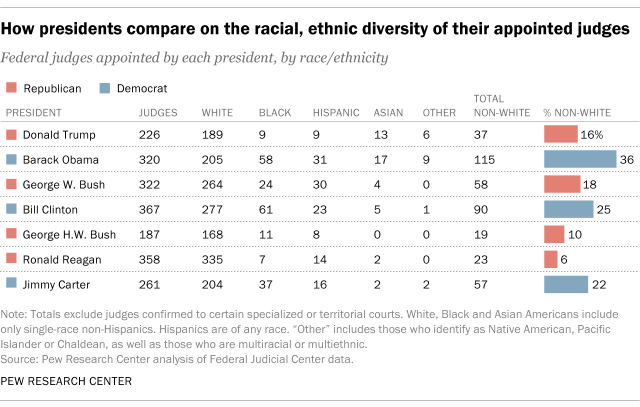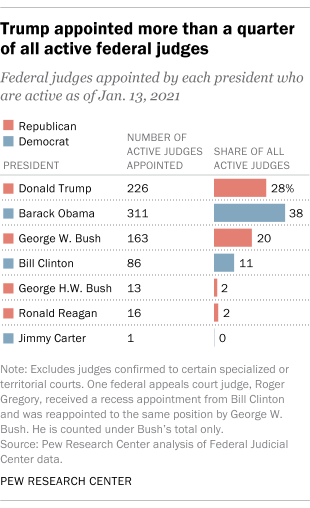Donald Trump leaves the White House having appointed more than 200 judges to the federal bench, including nearly as many powerful federal appeals court judges in four years as Barack Obama appointed in eight.
Trump, the nation’s 45th president, worked closely with Majority Leader Mitch McConnell and other Senate Republicans to reshape the federal judiciary – particularly the appeals courts – for decades to come. Federal judges have lifetime tenure and typically remain on the bench long after the presidents who nominated them have left office.
As his administration comes to an end, here’s a look at how Trump compares with his recent predecessors in the overall number and demographic characteristics of the judges he appointed. All findings are based on a Pew Research Center analysis of data from the Federal Judicial Center, the research and education arm of the federal judiciary.
Federal judicial appointments are an important part of a president’s legacy. As Donald Trump prepares to leave the White House, Pew Research Center conducted this analysis to find out how his record on judicial appointments compares with that of other recent presidents, going back to Jimmy Carter. The analysis is based on data published by the Federal Judicial Center, the research and education agency of the federal judicial branch.
The Center’s analysis focuses only on judges serving in the three main tiers of the federal court system: the Supreme Court, 13 appeals courts and 91 district courts governed by Article III of the U.S. Constitution. It excludes those appointed to certain specialized courts, such as the U.S. Court of International Trade, as well as appointees to non-Article III territorial courts in Guam, the Northern Mariana Islands and the Virgin Islands.
White judges in this analysis include only those who identify as single-race non-Hispanic, as reported by the Federal Judicial Center. Non-White judges include those who identify as Black, Hispanic, Asian, Native American or another race or ethnicity, as well as those who identify as multiracial or multiethnic.
Trump stands out for the large number of federal appeals court judges he appointed in only four years. Not surprisingly, the overall number of judges appointed by Trump in his single term (226) is well below the totals of recent two-term presidents, including Obama (320), George W. Bush (322) and Bill Clinton (367). But when it comes to the nation’s 13 federal appeals courts – which have the final word on most legal appeals around the country – Trump’s influence is clear.
Trump appointed 54 federal appellate judges in four years, one short of the 55 Obama appointed in twice as much time. In the process, Trump “flipped” the balance of several appeals courts from a majority of Democratic appointees to a majority of Republican appointees.
Trump also had a major influence on the nation’s highest court. The three Supreme Court justices he appointed – Neil Gorsuch, Brett Kavanaugh and Amy Coney Barrett – are the most by any president since Ronald Reagan (who appointed four) and the most by any one-term president since Herbert Hoover (though Richard Nixon appointed four in his first four years in office).
Gorsuch, Kavanaugh and Barrett are all age 55 or younger. A Pew Research Center analysis in 2017 found that past justices who were appointed to the court when they were 55 or younger ended up serving for an average of nearly two decades.
Trump was slightly more likely than other recent GOP presidents to appoint women to the federal judiciary, but less likely to do so than the last two Democratic presidents. Women account for around a quarter of Trump’s judicial appointees (24%). That’s a bit higher than the share of women judges appointed by Republicans George W. Bush (22%) and George H.W. Bush (19%), but below the proportion appointed by Democrats Obama (42%) and Clinton (28%).
Republican presidents have generally been less likely than Democrats to appoint women to the bench, but chief executives in both parties have increasingly done so. Trump’s appointment of Barrett to the Supreme Court in 2020 made her just the fifth woman ever to serve on the high court, after former justices Sandra Day O’Connor and Ruth Bader Ginsburg and current justices Sonia Sotomayor and Elena Kagan.
Trump appointed a smaller share of non-White federal judges than other recent presidents. About one-in-six of the judges appointed by Trump (16%) are Black, Hispanic, Asian or another race or ethnicity. That’s slightly below the proportion of non-White judges appointed by the last Republican president, George W. Bush (18%), and well below the share appointed by the last three Democratic presidents – Obama (36%), Clinton (25%) and Jimmy Carter (22%). As is the case with women judges, Democratic presidents have generally been more likely than their GOP counterparts to appoint racial or ethnic minorities to the bench.
It isn’t yet clear whether Democratic President-elect Joe Biden will need to fill a vacancy on the Supreme Court during his tenure. Should a vacancy arise, Biden has vowed to appoint a Black woman. No Black woman has ever served on the Supreme Court.
More than a quarter of currently active federal judges are now Trump appointees. As of Jan. 13, there were 816 active judges serving across the three main tiers of the federal court system: the Supreme Court, 13 regional appeals courts and 91 district courts governed by Article III of the U.S. Constitution. Trump appointed 28% of those judges. That includes three of the nine sitting Supreme Court justices, 30% of the nation’s active appeals court judges and 27% of active district court judges. (The number of active federal judges changes regularly because of retirements, resignations, new appointments and other reasons.)
Obama appointed the largest share of currently active federal judges at 38%, while George W. Bush named 20% of the total. Clinton appointed 11% and George H.W. Bush and Reagan each appointed 2%. One active federal judge, Carmen Consuelo Cerezo of the District of Puerto Rico, was appointed by Carter.
Note: This is an update of a post originally published on July 15, 2020.







